Leaf mold occasionally appears in high tunnel or greenhouse tomato production in New Jersey. However, under ideal conditions the disease will develop in field-grown crops. The fungus will cause infection under prolonged periods leaf wetness and when relative humidity remains above 85%. If relative humidity is below 85% the disease will not occur. Therefore, the proper venting of high tunnels and greenhouses on a regular basis is important. The pathogen can survive (overwinter) as a saprophyte on crop debris or as sclerotia in the soil. Conidia (spores) of the fungus can also survive up to one year in the soil.
Identifying and controlling leaf mold in high tunnel & greenhouse tomato production
Diagnosing pith necrosis in tomato
Symptoms usually begin to appear on random plants throughout the field as green fruit begins to mature. The bacterium (Pseudomonas corrugata) is ubiquitous to soils and develops when weather conditions (cooler nights/very hot, humid days) and cultural practices (i.e., excess heavy N use) lead to favorable conditions for disease development. Symptoms include the development of irregular greasy (at first), brown lesions on main stems and branches. Late pruning (i.e., suckering) can provide entry points for the bacterial disease. Internally, stems will become chocolate brown and mushy. High humidity is necessary for disease development. High nitrogen and lower night temperatures are associated with Pith Necrosis development, where it has been reported around the state this past week. Control begins with cultural practices such as avoiding working in fields with wet foliage, avoiding late pruning, tying when plants are wet, and watching the amount of N applied to plantings. Infected plants can be rouged from field and most often it does not spread to nearby uninfected plants.
Identifying and controlling Botrytis in high tunnel and greenhouse tomato production
Botrytis, or gray mold, caused by the fungus, Botrytis cinerea, can cause significant losses in high tunnel and greenhouse tomato production if not controlled properly. The pathogen can rapidly spread during periods when structures are closed and when relative humidity remains high for long periods of time. This often occurs when outside weather remains cool and damp while heating is needed. Gray mold is favored by temperatures from 64° to 75°F and requires only high humidity (not leaf wetness) to become established. The pathogen has a large host range and once established in an enclosed structure it can be very difficult to control (UMASS). The fungus can survive/overwinter as mycelia or sclerotia in plant debris and in organic soil matter (NCSU).
Diagnosing Southern blight and White mold in tomato and pepper
There have been a few reports of Southern blight (Sclerotinia rolfsii) and White mold (Sclerotinia sclerotiorum) on tomato and pepper in New Jersey. Southern blight is much more common in vegetable areas south of the state where summer temperatures remain hotter (above 90°F) for longer periods of time. Like white mold, it can survive in the soil for many years. Symptoms of Southern blight include infection at the base of the stem at the soil line. The resulting infection will girdle the plant causing wilt and death. The fungus will produce white, cottony mycelium and very small, spherical sclerotia which are often have a tannish, brown color.
White mold is more common than Southern blight in New Jersey, and like Southern blight, once introduced into a field or high tunnel it can very difficult to control. The pathogen produces large black sclerotia on the surface and inside infected stems. If sclerotia of either pathogen make their way back into the soil, both can survive for years causing significant problems.
All infected plants need to be removed immediately and disposed of properly to help reduce the chances of sclerotia returning to the soil.
For more information on chemical control please see the 2024/2025 mid-Atlantic Commercial Vegetable Production Recommendations Guide.
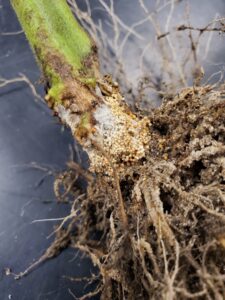
Symptoms of Southern blight on infected pepper plant. Note the numerous, small white to tan colored sclerotia on the stem.
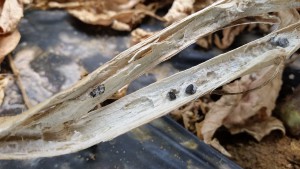
White mold of tomato. Note the large black sclerotia developing inside the brittle stems.
Tobacco Streak Virus (TSV) found on tomato in New Jersey
Tobacco Streak Virus (TSV) was found on fresh-market tomato this past week in southern New Jersey. TSV has a host range of close to 200 species, including cranberry, tobacco, tomato, pepper, asparagus, bean, soybean, mustard, radish, a number of ornamental hosts as well as weeds such as thistle, field bindweed, and jimson weed. Like Tomato Spotted Wilt Virus (TSWV), the Tobacco Streak Virus is also vectored by thrips. TSV can be seed-borne (reported in some hosts), spread via pollen, and mechanically transmitted. Symptoms can vary significantly depending on the host. Infected plants may have downward leaf curling, show black streaks on leaves and stems, chlorosis, stunted growth, deformed growing tips, ring spots, and flower drop. There is no genetic resistance to TSV in tomato and management should focus on keeping thrips populations as low as possible, scouting on a regular, removing infected plants, and knowing your weed population (as a potential source). The only method to correctly identify TSV is through serological tests such as ELISA.
For more information on Tomato Spotted Wilt Virus please click here.
Vegetable IPM Update 6/5/25
Greetings from the Veg IPM team!
Sweet Corn
With the hot weather, we’re starting to see sweet corn really coming along. Some plantings of sweet corn are silking (especially in the south), so it’s time to think about corn earworm management. Moth captures in the Southern part of the state (see map) are indicating that 4 and even 3 day intervals are necessary in some areas. Rotation is important for avoiding resistance, and there are four IRAC groups that are registered in silking sweet corn: 1 (carbamates), 3 (pyrethroids), 5 (spinosyns), and 28 (diamides). Corn earworm is at least partly resistant to several pyrethroids, so a spray program should not rely solely on pyrethroids, although they can be useful in tank-mixes or as pre-mixed products, such as Besiege or Elevest (Group 28 + Group 3). For detailed information about resistance and potential spray programs, the University of Delaware has an excellent resource on corn earworm management.
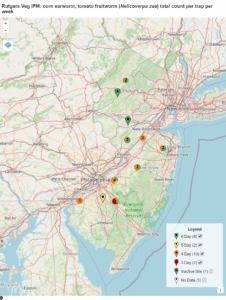
Spray intervals based on nightly pheromone moth captures for the southern part of New Jersey. Note that not all locations in the IPM program are currently trapping. This map is based on the following thresholds: 0 moths = 6-7 day schedule, 1 moth = 5 day spray schedule, 2-20 moths = 4 day spray schedule, 20+ moths = 3 day spray schedule.
Cole Crops
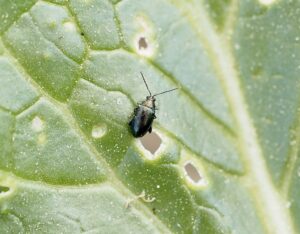
Flea beetle surrounded by feeding damage. Picture by Maria Cramer.
Flea beetle activity seems to be slowing down some, but they are still active in various cole crops. This year, they have been especially prevalent in lacinato kale, Napa cabbage and bok choy. Young plants are especially vulnerable to attack from flea beetles. The treatment threshold for flea beetles in heading cole crops is 50% infestation.
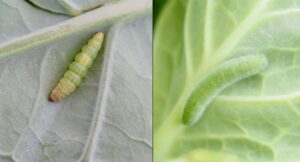
Left: Diamondback moth caterpillar, showing characteristic tapering at each end. Right: Imported cabbageworm caterpillar showing characteristic fuzziness. Pictures by Maria Cramer.
We’re still seeing caterpillar activity in cabbage and other cole crops. Treatment thresholds vary between crops and growth stage, but for heading cole crops between early vegetative and cupping, the treatment threshold is 30%. At this stage, sprayable Bt products (IRAC 11A) such as Dipel, Xentari, or Javelin can be effective on young imported cabbage worm caterpillars. Other materials approved for caterpillar control include Entrust/Radiant (IRAC 5), Proclaim (IRAC 6), Torac (IRAC 21A), and Exirel (IRAC 28). Diamondback moth has resistance to many insecticide groups, and pyrethroids (IRAC 3A) are not effective for their management. For Bt products and contact insecticides, coverage on the undersides the leaves is essential.
Tomatoes
In high tunnels and field plantings of tomatoes, we’re seeing limited aphid, thrips, and spider mite activity. If dealing with primarily aphids, products such as Beleaf (IRAC 29) are recommended, especially if plants have reached the flowering stage. We have seen aphid populations decline over the last couple of weeks without spray, probably due to natural enemies predation. For thrips, Entrust, Radiant (IRAC 5) and Torac (IRAC 21A) can be used. For spider mites, Nealta (IRAC 25) is an effective material that is more friendly to beneficial insects, but Portal (IRAC 21A) and other materials can be used to manage populations. We’ve seen very few Colorado potato beetles (CPB) in tomatoes, so while no controls are needed yet, we’ll keep an eye out for increasing populations.
Eggplants
In eggplants we have seen some damaging populations of CPB. For plants under 6 inches, 2 small/1 large larvae per plant is the threshold, while for plants taller than 6 inches, the threshold is 4 small/2 large larvae per plant. Adults are hard to kill, so sprays should target the larvae, with younger/smaller larvae being more vulnerable than older larvae. CPB has resistance to many classes of insecticides and is notorious for quickly developing resistance to new ones, so plan to rotate IRAC groups if you’ve already treated or need to treat more than once. If you haven’t used a neonic (IRAC 4) at planting or in the drip, you can use a foliar neonic like Assail or a spinosyn like Entrust or Radiant (IRAC 5). Avoid IRAC 5 groups if you’ve already used a neonic, because there is risk of cross resistance. Diamide products like Coragen and Exirel (IRAC 28), Rimon (IRAC 15), and Torac (IRAC 21A) should all give good control.
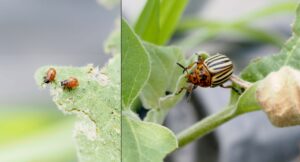
Left: Colorado potato beetle larvae and feeding damage on an eggplant leaf. Right: Adult Colorado potato beetle. Photos by Maria Cramer.
Diseases
We’ve detected bacterial diseases of tomatoes and peppers on a few farms in the central and northern parts of the state (see photos below). Copper may help mitigate symptoms, but some strains have developed resistance due to continued copper use. Other products that may help include Actigard and Quintec. Otherwise, properly managing nutrients and growing conditions for the plant will be crucial for reducing the severity of this disease.
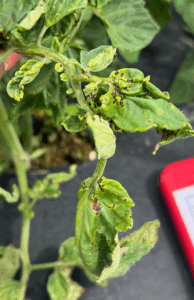
Bacterial leaf spot on tomato. Photo by Amanda Quadrel
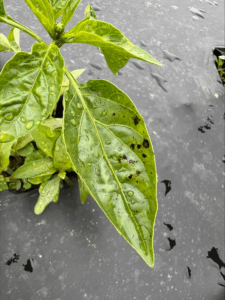
Bacterial leaf spot on pepper. Photo by Amanda Quadrel.
Please consult the Mid-Atlantic Commercial Vegetable Production Guide for a more comprehensive list of materials that are labeled for specific crops and pests. As always, be sure to follow label rates and application instructions.
Authors: Amanda Quadrel (Northern NJ Veg IPM coordinator) and Maria Cramer (Southern NJ Veg IPM coordinator)

